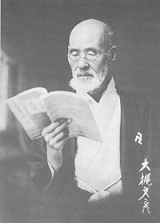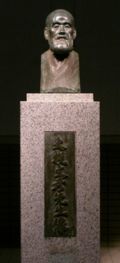
Otsuki Fumihiko
Encyclopedia
was a Japanese lexicographer, linguist
, and historian
. He is best known for two Japanese-language
dictionaries
that he edited, Genkai (言海, literally "sea of words," 1891) and its successor Daigenkai (大言海, literally "great sea of words," 1932–1937), and for his studies of Japanese grammar
.
in what is now part of Ginza
, Tokyo
. He was the third son of the Confucian
scholar and gunnery expert and the grandson of the Confucian and Western scholar . Following family tradition, he embarked on Western studies
, studying English
and mathematics at the Kaiseijo school (one of the predecessors of the University of Tokyo
).
As a youth, Ōtsuki was employed as an advisor to Sendai Domain
, and fought at the Battle of Toba-Fushimi
in the Boshin War
of the Meiji Restoration
on the losing Tokugawa Bakufu side. He later assisted in the formation of the Ōuetsu Reppan Dōmei
.
After the Meiji Restoration
, he worked as a translator while learning English from Americans in the port city of Yokohama
. Around 1872, he joined in the editing of an English–Japanese dictionary for the Ministry of Education
, and he later worked on textbooks and taught at schools in Miyagi Prefecture
.
Although Ōtsuki paid for the original publication expenses for Genkai himself, it was soon republished and expanded in commercial editions that went through over a thousand printings. Modeled in part on Western monolingual dictionaries, Genkai gave not only basic information about words—their representations in kana
and kanji
and their definitions in Japanese—but also pronunciations and etymologies
and citations of their use. Its successor, the four-volume Daigenkai, though published under Ōtsuki's name and based in part on his work, appeared some years after his death and was completed by other lexicographers.
 Ōtsuki's grammatical works, especially and , strongly influenced the teaching of Japanese grammar
Ōtsuki's grammatical works, especially and , strongly influenced the teaching of Japanese grammar
for generations to come.
Linguistics
Linguistics is the scientific study of human language. Linguistics can be broadly broken into three categories or subfields of study: language form, language meaning, and language in context....
, and historian
Historian
A historian is a person who studies and writes about the past and is regarded as an authority on it. Historians are concerned with the continuous, methodical narrative and research of past events as relating to the human race; as well as the study of all history in time. If the individual is...
. He is best known for two Japanese-language
Japanese language
is a language spoken by over 130 million people in Japan and in Japanese emigrant communities. It is a member of the Japonic language family, which has a number of proposed relationships with other languages, none of which has gained wide acceptance among historical linguists .Japanese is an...
dictionaries
Dictionary
A dictionary is a collection of words in one or more specific languages, often listed alphabetically, with usage information, definitions, etymologies, phonetics, pronunciations, and other information; or a book of words in one language with their equivalents in another, also known as a lexicon...
that he edited, Genkai (言海, literally "sea of words," 1891) and its successor Daigenkai (大言海, literally "great sea of words," 1932–1937), and for his studies of Japanese grammar
Japanese grammar
The Japanese language has a regular agglutinative verb morphology, with both productive and fixed elements. In language typology, it has many features divergent from most European languages. Its phrases are exclusively head-final and compound sentences are exclusively left-branching. There are many...
.
Biography
Ōtsuki Fumihiko was born in the section of EdoEdo
, also romanized as Yedo or Yeddo, is the former name of the Japanese capital Tokyo, and was the seat of power for the Tokugawa shogunate which ruled Japan from 1603 to 1868...
in what is now part of Ginza
Ginza
is a district of Chūō, Tokyo, located south of Yaesu and Kyōbashi, west of Tsukiji, east of Yūrakuchō and Uchisaiwaichō, and north of Shinbashi.It is known as an upscale area of Tokyo with numerous department stores, boutiques, restaurants and coffeehouses. Ginza is recognized as one of the most...
, Tokyo
Tokyo
, ; officially , is one of the 47 prefectures of Japan. Tokyo is the capital of Japan, the center of the Greater Tokyo Area, and the largest metropolitan area of Japan. It is the seat of the Japanese government and the Imperial Palace, and the home of the Japanese Imperial Family...
. He was the third son of the Confucian
Confucianism
Confucianism is a Chinese ethical and philosophical system developed from the teachings of the Chinese philosopher Confucius . Confucianism originated as an "ethical-sociopolitical teaching" during the Spring and Autumn Period, but later developed metaphysical and cosmological elements in the Han...
scholar and gunnery expert and the grandson of the Confucian and Western scholar . Following family tradition, he embarked on Western studies
Rangaku
Rangaku is a body of knowledge developed by Japan through its contacts with the Dutch enclave of Dejima, which allowed Japan to keep abreast of Western technology and medicine in the period when the country was closed to foreigners, 1641–1853, because of the Tokugawa shogunate’s policy of national...
, studying English
English language
English is a West Germanic language that arose in the Anglo-Saxon kingdoms of England and spread into what was to become south-east Scotland under the influence of the Anglian medieval kingdom of Northumbria...
and mathematics at the Kaiseijo school (one of the predecessors of the University of Tokyo
University of Tokyo
, abbreviated as , is a major research university located in Tokyo, Japan. The University has 10 faculties with a total of around 30,000 students, 2,100 of whom are foreign. Its five campuses are in Hongō, Komaba, Kashiwa, Shirokane and Nakano. It is considered to be the most prestigious university...
).
As a youth, Ōtsuki was employed as an advisor to Sendai Domain
Sendai Domain
was a Japanese domain of the Edo period. Most of its holdings were contiguous, covering all of modern-day Miyagi Prefecture, small portions of southern Iwate Prefecture, and a portion of northeastern Fukushima Prefecture. The domain's capital, and the ruling family's castle, were located in what...
, and fought at the Battle of Toba-Fushimi
Battle of Toba-Fushimi
The occurred between pro-Imperial and Tokugawa shogunate forces during the Boshin War in Japan. The battle started on 27 January 1868 , when the forces of the Tokugawa shogunate and the allied forces of Chōshū, Satsuma and Tosa domains clashed near Fushimi...
in the Boshin War
Boshin War
The was a civil war in Japan, fought from 1868 to 1869 between forces of the ruling Tokugawa shogunate and those seeking to return political power to the imperial court....
of the Meiji Restoration
Meiji Restoration
The , also known as the Meiji Ishin, Revolution, Reform or Renewal, was a chain of events that restored imperial rule to Japan in 1868...
on the losing Tokugawa Bakufu side. He later assisted in the formation of the Ōuetsu Reppan Dōmei
Ouetsu Reppan Domei
-External links:**...
.
After the Meiji Restoration
Meiji Restoration
The , also known as the Meiji Ishin, Revolution, Reform or Renewal, was a chain of events that restored imperial rule to Japan in 1868...
, he worked as a translator while learning English from Americans in the port city of Yokohama
Yokohama
is the capital city of Kanagawa Prefecture and the second largest city in Japan by population after Tokyo and most populous municipality of Japan. It lies on Tokyo Bay, south of Tokyo, in the Kantō region of the main island of Honshu...
. Around 1872, he joined in the editing of an English–Japanese dictionary for the Ministry of Education
Ministry of Education, Culture, Sports, Science and Technology (Japan)
The , also known as MEXT or Monkashō, is one of the ministries of the Japanese government.The Meiji government created the first Ministry of Education in 1871....
, and he later worked on textbooks and taught at schools in Miyagi Prefecture
Miyagi Prefecture
is a prefecture of Japan in the Tōhoku Region on Honshu island. The capital is Sendai.- History :Miyagi Prefecture was formerly part of the province of Mutsu. Mutsu Province, on northern Honshu, was one of the last provinces to be formed as land was taken from the indigenous Emishi, and became the...
.
Although Ōtsuki paid for the original publication expenses for Genkai himself, it was soon republished and expanded in commercial editions that went through over a thousand printings. Modeled in part on Western monolingual dictionaries, Genkai gave not only basic information about words—their representations in kana
Kana
Kana are the syllabic Japanese scripts, as opposed to the logographic Chinese characters known in Japan as kanji and the Roman alphabet known as rōmaji...
and kanji
Kanji
Kanji are the adopted logographic Chinese characters hanzi that are used in the modern Japanese writing system along with hiragana , katakana , Indo Arabic numerals, and the occasional use of the Latin alphabet...
and their definitions in Japanese—but also pronunciations and etymologies
Etymology
Etymology is the study of the history of words, their origins, and how their form and meaning have changed over time.For languages with a long written history, etymologists make use of texts in these languages and texts about the languages to gather knowledge about how words were used during...
and citations of their use. Its successor, the four-volume Daigenkai, though published under Ōtsuki's name and based in part on his work, appeared some years after his death and was completed by other lexicographers.

Japanese grammar
The Japanese language has a regular agglutinative verb morphology, with both productive and fixed elements. In language typology, it has many features divergent from most European languages. Its phrases are exclusively head-final and compound sentences are exclusively left-branching. There are many...
for generations to come.

